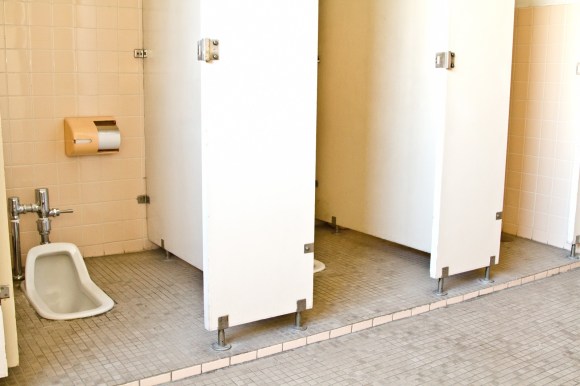
Japanese Twitter user reopens debate on Japanese-style squat toilet etiquette, but is it just a flush in the pan?
Japan may be famous for its all-singing, all-dancing “washlet” toilets with their warmed seats, auto-lifting lids and more buttons and nozzles than a fire engine wearing a cardigan, but the traditional Japanese-style toilet deserves to be equally well-known for its ability to puzzle and confuse even the people who are supposed to know how to use it, let alone foreign visitors.
Like a porcelain trough in the ground, the Japanese-style “squat” toilet has gradually been replaced by Western-style toilets but can still be found in places as diverse as public toilets in parks or motorway service stations and upscale department stores. You use the toilet by straddling it with one foot either side but which way should you be facing? Japanese Twitter user @mikaduki_neko reignited the online debate by suggesting that the origins of the “kinkakushi“, the hood-like part that covers the drainage hole, mean that you should be facing away from it rather than towards as most Japanese are taught.
以前話題になった時
— 三日月ネコ🧩 (@mikaduki_neko) December 9, 2017
みんな和式トイレの使い方間違えてるという
事実に驚愕したやつのまとめ pic.twitter.com/DUynj94Ni0
According to @mikaduki_neko, the kinkakushi was originally a wooden stand where the hygiene-conscious samurai wanting to drop their kids off at the pool could safely hang their hakama skirt trousers up without them falling into the muck. Supposedly, another reason is that by doing your business at the end nearer the drainage hole you dirty less of the toilet, making for easier and less time-consuming cleaning.
Twitter user @snufkin_p countered with a picture taken from the Toto, Japan’s and indeed the world’s biggest producer of toilets and owners of the town of Kitakyushu’s premier toilet museum, website. The picture suggests the opposite, you should be facing the kinkakushi hood when you go. Or that when riding a giant slipper you should be facing forwards.
というか紙の設置位置からして昔はともかく現在は金隠しが前、でいいと思う。 pic.twitter.com/cl8IZHLjox
— 砂布巾 (@snufkin_p) December 9, 2017
Educational posters for kids, like this one Twitter user @Akatki334 posted, also suggest the opposite, although I’m not sure putting a face on the kinkakushi and toilet paper is necessarily a good idea; I wouldn’t be able to look them in the eye again after what I’d done to them.
https://twitter.com/jetpack/status/939391285428764672Being an issue close to a number of hearts, Japanese social media users were quick to add their opinion.
“Ah! I’ve been getting it wrong the whole time!”
“Really? But if you want to do a number one wouldn’t it fly everywhere.”
“If you go straight into the drain hole end wouldn’t it make a loud plop sound that everyone could hear?”
“If so, why did the one with the ‘X” become normal?”
Of course it seems that while not everyone knows how to use a Japanese-style toilet correctly, if there is in fact an incorrect way to use it provided you don’t make a mess, there must also be people who aren’t familiar with the right way to use a Western-style toilet, if this sign from Kansai airport is anything to go by.
洋式トイレで、こんな使い方するヤツいるのかいな?
— silverrain@latex.jp (@silverrain_2017) October 17, 2017
※関西空港のトイレで目撃…。 pic.twitter.com/QqhSIX2IyT
Still, despite the history of the kinkakushi and the Japanese squat-style toilet, Toto maintains that people should face the hood while squatting instead of away from it. While they may look intimidating, there are loads of reasons why squat toilets are actually great, but if you’re planning on wearing hakama when you use one, you may need to bring your own wooden stand to hang them up on.
Source: Twitter/@mikaduki_neko via jin115
Top image: Pakutaso

 Squat toilets’ popularity fading as parents call for them to be abolished in Japanese schools
Squat toilets’ popularity fading as parents call for them to be abolished in Japanese schools Everything you think you know about your washlet toilet is wrong
Everything you think you know about your washlet toilet is wrong Kyoto village dealing with poo on floor as Japanese-style toilets confuse foreign travelers
Kyoto village dealing with poo on floor as Japanese-style toilets confuse foreign travelers Do you really need to wear toilet slippers when using the bathroom at home? Japan’s netizens vote
Do you really need to wear toilet slippers when using the bathroom at home? Japan’s netizens vote Use this Japanese-style toilet properly, or else “you are gonna fall down on s***”
Use this Japanese-style toilet properly, or else “you are gonna fall down on s***” Sandwiches fit for a sumo served up in Osaka【Taste Test】
Sandwiches fit for a sumo served up in Osaka【Taste Test】 Red light district sushi restaurant in Tokyo shows us just how wrong we were about it
Red light district sushi restaurant in Tokyo shows us just how wrong we were about it Haku is…Chihiro’s dead brother? Studio Ghibli fans blown away by Spirited Away theory
Haku is…Chihiro’s dead brother? Studio Ghibli fans blown away by Spirited Away theory Tokyo Tsukiji fish market site to be redeveloped with 50,000-seat stadium, hotel, shopping center
Tokyo Tsukiji fish market site to be redeveloped with 50,000-seat stadium, hotel, shopping center Japan’s massive matcha parfait weighs 6 kilos, contains hidden surprises for anyone who eats it
Japan’s massive matcha parfait weighs 6 kilos, contains hidden surprises for anyone who eats it Limited-edition Carbonara Udon will anger noodle purists and pasta lovers 【Taste test】
Limited-edition Carbonara Udon will anger noodle purists and pasta lovers 【Taste test】 Beautiful Ghibli sealing wax kits let you create accessories and elegant letter decorations【Pics】
Beautiful Ghibli sealing wax kits let you create accessories and elegant letter decorations【Pics】 McDonald’s new Happy Meals offer up cute and practical Sanrio lifestyle goods
McDonald’s new Happy Meals offer up cute and practical Sanrio lifestyle goods Historical figures get manga makeovers from artists of Spy x Family, My Hero Academia and more
Historical figures get manga makeovers from artists of Spy x Family, My Hero Academia and more Anime girl English teacher Ellen-sensei becomes VTuber/VVTUber and NFT
Anime girl English teacher Ellen-sensei becomes VTuber/VVTUber and NFT All-you-can-drink Starbucks and amazing views part of Tokyo’s new 170 meter-high sky lounge
All-you-can-drink Starbucks and amazing views part of Tokyo’s new 170 meter-high sky lounge More foreign tourists than ever before in history visited Japan last month
More foreign tourists than ever before in history visited Japan last month Japanese ramen restaurants under pressure from new yen banknotes
Japanese ramen restaurants under pressure from new yen banknotes French Fries Bread in Tokyo’s Shibuya becomes a hit on social media
French Fries Bread in Tokyo’s Shibuya becomes a hit on social media Studio Ghibli releases new action figures featuring Nausicaä of the Valley of the Wind characters
Studio Ghibli releases new action figures featuring Nausicaä of the Valley of the Wind characters New private rooms on Tokaido Shinkansen change the way we travel from Tokyo to Kyoto
New private rooms on Tokaido Shinkansen change the way we travel from Tokyo to Kyoto Starbucks reopens at Shibuya Scramble Crossing with new look and design concept
Starbucks reopens at Shibuya Scramble Crossing with new look and design concept Studio Ghibli glasses cases let anime characters keep an eye on your spectacles
Studio Ghibli glasses cases let anime characters keep an eye on your spectacles Studio Ghibli releases Kiki’s Delivery Service chocolate cake pouches in Japan
Studio Ghibli releases Kiki’s Delivery Service chocolate cake pouches in Japan New definition of “Japanese whiskey” goes into effect to prevent fakes from fooling overseas buyers
New definition of “Japanese whiskey” goes into effect to prevent fakes from fooling overseas buyers Our Japanese reporter visits Costco in the U.S., finds super American and very Japanese things
Our Japanese reporter visits Costco in the U.S., finds super American and very Japanese things Studio Ghibli unveils Mother’s Day gift set that captures the love in My Neighbour Totoro
Studio Ghibli unveils Mother’s Day gift set that captures the love in My Neighbour Totoro New Japanese KitKat flavour stars Sanrio characters, including Hello Kitty
New Japanese KitKat flavour stars Sanrio characters, including Hello Kitty New Pokémon cakes let you eat your way through Pikachu and all the Eevee evolutions
New Pokémon cakes let you eat your way through Pikachu and all the Eevee evolutions Disney princesses get official manga makeovers for Manga Princess Cafe opening in Tokyo
Disney princesses get official manga makeovers for Manga Princess Cafe opening in Tokyo Sales of Japan’s most convenient train ticket/shopping payment cards suspended indefinitely
Sales of Japan’s most convenient train ticket/shopping payment cards suspended indefinitely Sold-out Studio Ghibli desktop humidifiers are back so Totoro can help you through the dry season
Sold-out Studio Ghibli desktop humidifiers are back so Totoro can help you through the dry season Japanese government to make first change to romanization spelling rules since the 1950s
Japanese government to make first change to romanization spelling rules since the 1950s Ghibli founders Toshio Suzuki and Hayao Miyazaki contribute to Japanese whisky Totoro label design
Ghibli founders Toshio Suzuki and Hayao Miyazaki contribute to Japanese whisky Totoro label design Doraemon found buried at sea as scene from 1993 anime becomes real life【Photos】
Doraemon found buried at sea as scene from 1993 anime becomes real life【Photos】 Tokyo’s most famous Starbucks is closed
Tokyo’s most famous Starbucks is closed One Piece characters’ nationalities revealed, but fans have mixed opinions
One Piece characters’ nationalities revealed, but fans have mixed opinions We asked a Uniqlo employee what four things we should buy and their suggestions didn’t disappoint
We asked a Uniqlo employee what four things we should buy and their suggestions didn’t disappoint Princesses, fruits, and blacksmiths: Study reveals the 30 most unusual family names in Japan
Princesses, fruits, and blacksmiths: Study reveals the 30 most unusual family names in Japan $11,000 luxury Japanese toilet will probably give you the best poop experience of your life
$11,000 luxury Japanese toilet will probably give you the best poop experience of your life World’s largest toilet manufacturer lets you assemble your very own miniature paper toilet
World’s largest toilet manufacturer lets you assemble your very own miniature paper toilet She just popped up from your toilet paper to say hello!
She just popped up from your toilet paper to say hello! Japanese squat toilet plastic model kit: Weird, gross, or both?【Photos】
Japanese squat toilet plastic model kit: Weird, gross, or both?【Photos】 People in Japan are now stealing toilet paper in midst of coronavirus crisis
People in Japan are now stealing toilet paper in midst of coronavirus crisis Nagoya City Council debates: Is toilet paper really needed in public restrooms?
Nagoya City Council debates: Is toilet paper really needed in public restrooms? Flush your prayers down the toilet at this unique Japanese temple
Flush your prayers down the toilet at this unique Japanese temple Japan has established itself as King of the Thrones【Video】
Japan has established itself as King of the Thrones【Video】 Japanese toilet fans rejoice — bidet-style washlet water guns are here!
Japanese toilet fans rejoice — bidet-style washlet water guns are here! Turn your water bottle into a Japanese toilet!
Turn your water bottle into a Japanese toilet! Japan travel warning: These are not baby wipes, so don’t use them to wipe your butt
Japan travel warning: These are not baby wipes, so don’t use them to wipe your butt Japanese Twitter user spends eight years stacking toilet paper cores, completes entire wall
Japanese Twitter user spends eight years stacking toilet paper cores, completes entire wall “Shogun sound” toilet hack covers the sound of your pooping with samurai battle cries【Video】
“Shogun sound” toilet hack covers the sound of your pooping with samurai battle cries【Video】 New Japanese video game lets you compete in an international toilet racing circuit
New Japanese video game lets you compete in an international toilet racing circuit Attack on Toilets now going on inside Osaka train station bathrooms
Attack on Toilets now going on inside Osaka train station bathrooms Japanese poopers show strong enthusiasm for new portable banana toilet【Videos】
Japanese poopers show strong enthusiasm for new portable banana toilet【Videos】
Leave a Reply